
Host Lloyd Bridges takes you on a tour of motorsports in the 60’s. Cobra test at Riverside with Ken Miles, Shelby driver of the era. See the 007 Bond Aston Martin and Sean Connery, slot car racing, bubbletops, Craig Breedlove at salt flats, classic drag racing, and big daddy Ed Roth. This is a 40 min. transport back in time. You will be light-headed watching this show. It is the complete uncut version broadcast Thursday, Sept 8, 1967, on CBS. This is a digital re-master directly from film. It looks great! Bonus
Feature: Motor Mouth Pilot
Live the time machine from 1967 to 2002. See how when things change they really stay the same! Take a ride with hosts Barbi Orr and Jane Norris as they run their motor mouth at events like Willow Springs, You will see many cars from the 60’s still racing today: Cobras, GT350, Vettes, and many others. Also celebrity interviews – see how today’s high-tech BLING BLING WHEELS are designed by Keith Kaucher (today’s top wheel designer). Go to a hidden speed shop in Culver City, Calif., where top master mechanic Steve Beck stores the rarest cars you’ll ever see!
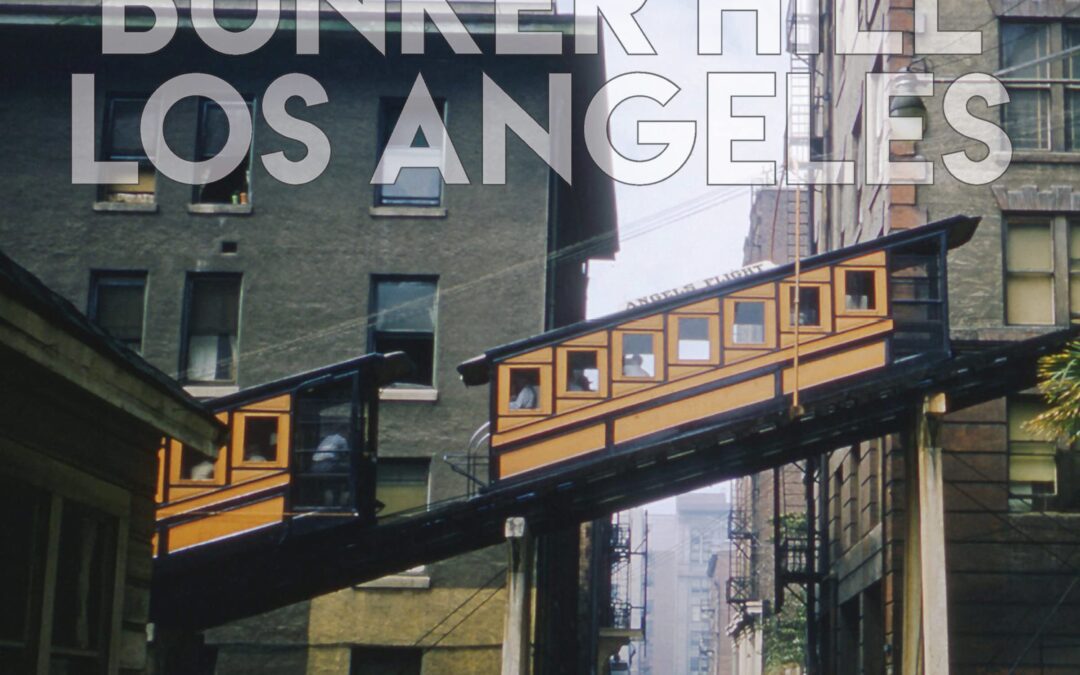
Bunker Hill is the highest point of downtown Los Angeles, both literally and figuratively. Its circle of life has created a continuous saga of change, each chapter rich with captivating characters, structures, and culture. In Bunker Hill Los Angeles: Essence of Sunshine and Noir, historian Nathan Marsak tells the story of the Hill, from the district’s inception in the mid-19th century to its present day. Once home to wealthy Angelenos living in LA’s “first suburb,” then the epicenter of the city’s shifting demographics and the shadow and vice of an urban underbelly, Bunker Hill survived its attempted erasure and burgeoned as a hub of arts, politics, business, and tourism.
As compelling as the story of the destruction of Bunker Hill is―with all the good intentions and bad results endemic to city politics―it was its people who made the Hill at once desirable and undesirable. Marsak commemorates the poets and writers, artists and activists, little guys and big guys, and of course, the many architects who built and rebuilt the community on the Hill―time after historic time.
Any fan of American architecture will treasure Marsak’s analysis of buildings that have crowned the Hill: the exuberance of Victorian shingle and spindlework, from Mission to Modern, from Queen Anne to Frank Gehry, Bunker Hill has been home to it all, the ever-changing built environment.
With more than 250 photographs―many in color―as well as maps and vintage ephemera to tell his dramatic visual story, Marsak lures us into Bunker Hill Los Angeles and shares its lost world, then guides us to its new one.
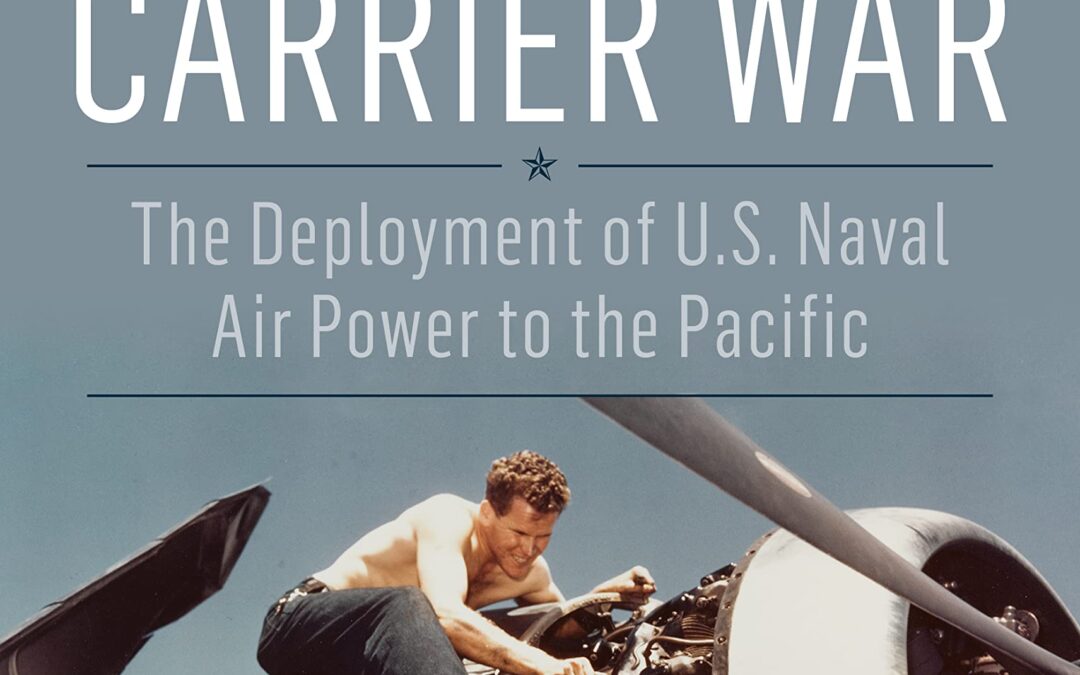
The ability of the United States Navy to fight and win a protracted war in the Pacific was not solely the result of technology, tactics, or leadership. Naval aviation maintenance played a major role in the U.S. victory over Japan in the second World War. The naval war against Japan did not achieve sustained success until enough aircraft technicians were available to support the high tempo of aviation operations that fast carrier task force doctrine demanded. When the United States realized war was imminent and ordered a drastic increase in the size of its aviation fleet, the Navy was forced to reconsider its earlier practices and develop new policies in maintenance, supply, and technical training. Not only did a shortage of technicians plague the Navy, but the scarcity of aviation supply and repair facilities in the Pacific soon caused panic in Washington. While the surface Navy’s modernization of at-sea replenishment was beneficial, it did not solve the problems of sustaining war-time aircraft readiness levels sufficient to a winning a naval air war. Fisher outlines the drastic institutional changes that accompanied an increase in aviation maintenance personnel from fewer than 10,000 to nearly 250,000 bluejackets, the complete restructuring of the naval aviation technical educational system, and the development of a highly skilled labor force. The first comprehensive study on the importance of aircraft maintenance and the aircraft technician in the age of the aircraft carrier, Sustaining the Carrier War, provides the missing link to our understanding of Great Power conflict at sea.
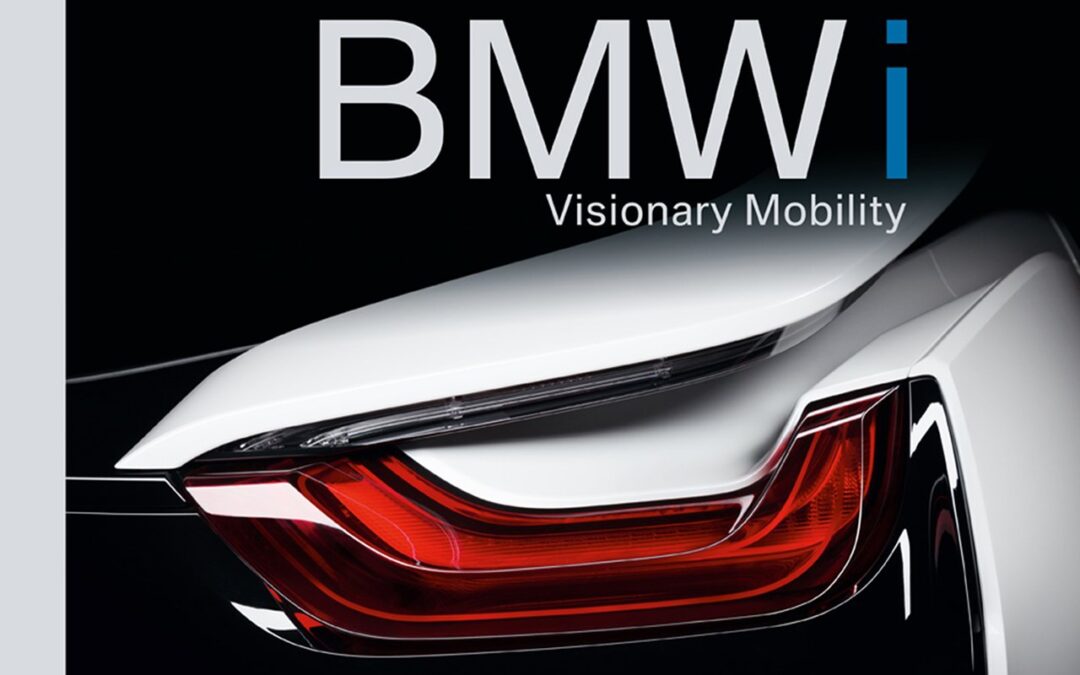
In the spring of 2008, a think tank of engineers, designers, trend researchers, and financial experts met on a factory floor of BMW’s parent plant in Munich to rethink mobility for a world of dwindling resources. Providing extensive insight into BMW’s workshop of ideas, this volume traces the venture’s design history and looks to the future of sustainable cars.
Grappling with major challenges of our time—from climate change to megacities and the scarcity of resources—contributors imagine solutions taking shape through technological innovations, networked mobility, sustainability in production, and the use of renewable materials. A unique look behind the scenes, this volume opens a window onto BMW’s complete development process, from initial conception to world premiere, presenting models for everything from plug-in hybrids with eucalyptus wood interiors to full-electric, self-driving cars. Replete with close-up photographs and fascinating model drawings, BMW i is a must-have for lovers of modern design and automobiles and for anyone interested in electro-mobility and sustainable technologies.
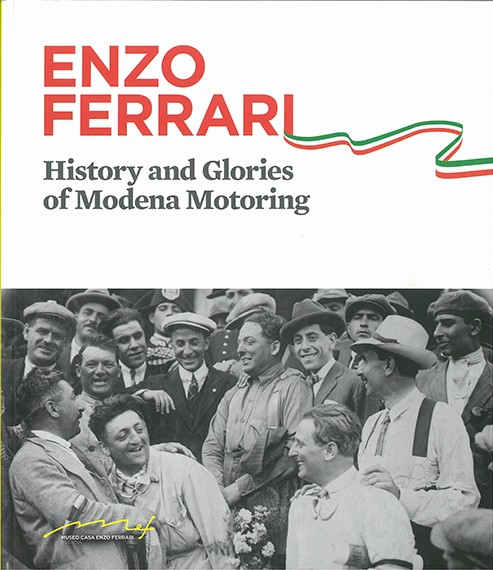
Enzo Ferrari would not have been Enzo Ferrari without Modena, a city and a territory that created a unique treasure or technical skills, artistic values and human abilities all focused on racing cars. Modena would not have become the world capital of racing cars without Enzo Ferrari, who was born here, where he founded and managed his Scuderia, who lived in town, commuting every day to Maranello where the carat bat bear both his name and the prancing horse are produced.
This book summarizes Enzo Ferrari’s life. He was bornin one of the buildings that form the museum. Just like the Scuderia Ferrari with its Alfa Romeo and Ferrari cars, from 1947 onwards Modena appears as a protagonist not only as a background. The second part of the book is dedicated to the glories of Modena car racing, in a flashback which starts at the beginning of the twentieth century, and finishes, by choice, in the 1970’s.
Times and circumstances have changed, but if what the Museum and this book tell us had not happened, today, the pages dedicated to the Rosse would be empty.
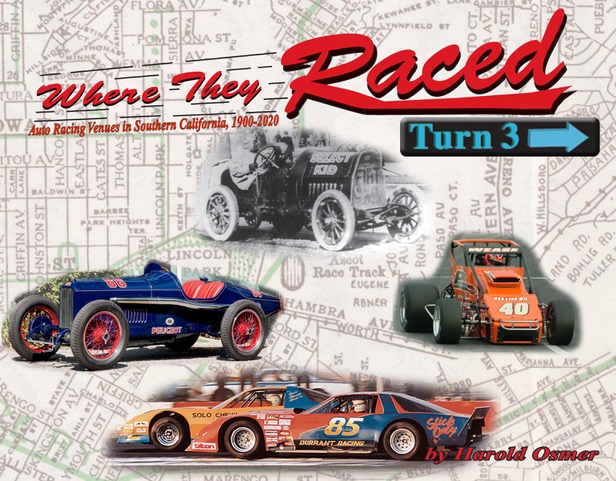
“More auto racing has taken place in Southern California than any other place in the world.”
Where They Raced Turn3 is the long awaited revision of the original classic Where They Raced (out of print since 2012). The history remains unchanged but more images have been uncovered, stories are more detailed, and overall venue coverage is expanded upon.
The first official automotive meet in Southern California took place at Agricultural Park (eventual site of the Los Angeles Coliseum) during Fiesta Week in 1903. This spawned 178 additional auto racing venues ranging from Real Road Races to Board Track Speedways, Short Tracks, Big Ovals, and Drag Strips.
Venues appeared in Santa Monica, Beverly Hills, and on the current sites of Sea World in San Diego and Television City in Los Angeles along with four very different race tracks called “Ascot”(!).
Where They Raced Turn3 traces the rise-fall and rise again of auto racing and its impact on the urban landscape throughout Southern California. This book is less about Who and What raced in favor of the When and (right!) Where they raced. Chances are good that there was an auto racing venue within a few miles of wherever you are in Southern California. Look around, and listen for the echoes of the motors and the cheers from the fans…

Carroll Shelby wasn’t born to run. He was born to race some of the fastest cars ever to tear up a speedway.
Carroll Shelby wasn’t born to run. He was born to race some of the fastest cars ever to tear up a speedway. The exciting new feature film Ford v Ferrari–starring Matt Damon as Shelby and Christian Bale as fellow racer Ken Miles–immortalizes the small-town Texas boy who won the notorious Le Mans 24-hour endurance challenge, and changed the face of auto racing with the legendary Shelby Cobra. But there’s much more to his high-velocity, history-making story.
A wizard behind the wheel, he was also a visionary designer of speed machines that ruled the racetrack and the road. While his GT40s racked up victories in the world’s most prestigious professional racing showdowns, his masterpiece, the Ford Cobra, gave Europe’s formidable Ferrari an American–style run for its money. If you’ve got a need for speed, strap in next to the man who put his foot down on the pedal, kept his eyes on the prize, and never looked back.
Originally published in 1965 as The Cobra Story by Carroll Shelby
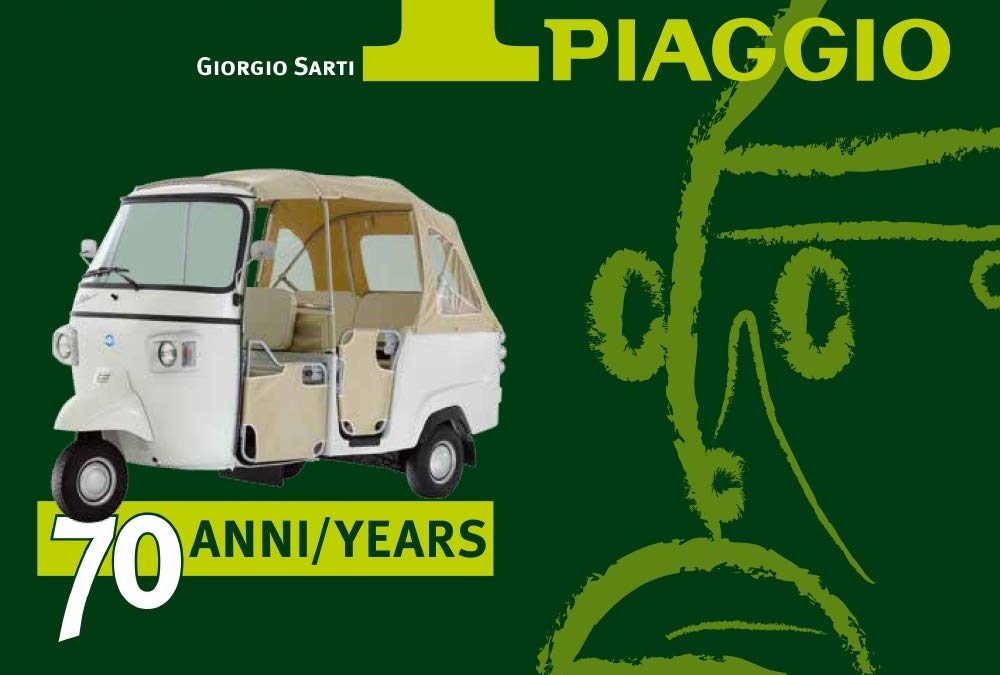
This is the book about the Ape Piaggio ‘three wheeler’ – that was waiting to be written, with a wealth of illustrations and completed with a comprehensive listing of all the models produced through to the present day.
In the years immediately after the Second World War, Italy was in desperate need of reconstruction, economic resources were scarce and there was above all a lack of a vehicle capable of satisfying the new commercial reality. On the one hand the market was offering large and expensive lorries, on the other cheap, small motorcycles but neither was suitable for small businesses. This changed in 1947 (just a year after the launch of the Vespa) with the presentation of the Ape that from the outset enjoyed enormous success and was offered in an infinite series of variants: flat beds, panel vans, tipper trucks, trailers, auto rickshaws and fire trucks. The company is a success story that has continued through to the present day, with special versions built for the Pope and the President of the Italian Republic.
Until now there had never been a book capable of tackling the Ape phenomenon in its totality. This book presents the history and the engineering of a remarkable vehicle, taking in such aspects and styling and publicity, not to mention the great intercontinental journeys undertaken with this legendary three-wheeler. Lastly, along with the production figures, for the first time we are publishing a complete illustrated catalogue of every model produced to date, each accompanied by a detailed technical file.

From the acclaimed author of “Birdmen” comes a revelatory new history of the birth of the automobile, an illuminating and entertaining true tale of invention, competition, and the visionaries, hustlers, and swindlers who came together to transform the world.
In 1900, the Automobile Club of America sponsored the nation s first car show in New York s Madison Square Garden. The event was a spectacular success, attracting seventy exhibitors and nearly fifty thousand visitors. Among the spectators was an obscure would-be automaker named Henry Ford, who walked the floor speaking with designers and engineers, trying to gauge public enthusiasm for what was then a revolutionary invention. His conclusion: the automobile was going to be a fixture in American society, both in the city and on the farm and would make some people very rich. None, he decided, more than he.
“Drive!” is the most complete account to date of the wild early days of the auto age. Lawrence Goldstone tells the fascinating story of how the internal combustion engine, a theory looking for an application, evolved into an innovation that would change history. Debunking many long-held myths along the way, “Drive!” shows that the creation of the automobile was not the work of one man, but very much a global effort. Long before anyone had heard of Henry Ford, men with names like Benz, Peugeot, Renault, and Daimler were building and marketing the world s first cars.
Goldstone breathes life into an extraordinary cast of characters: the inventors and engineers who crafted engines small enough to use on a horseless carriage; the financiers who risked everything for their visions; the first racers daredevils who pushed rickety, untested vehicles to their limits; and such visionary lawyers as George Selden, who fought for and won the first patent for the gasoline-powered automobile. Lurking around every corner is Henry Ford, a brilliant innovator and an even better marketer, a tireless promoter of his products and of himself.
With a narrative as propulsive as its subject, “Drive! “plunges us headlong into a time unlike any in history, when near-manic innovation, competition, and consumerist zeal coalesced to change the way the world moved.
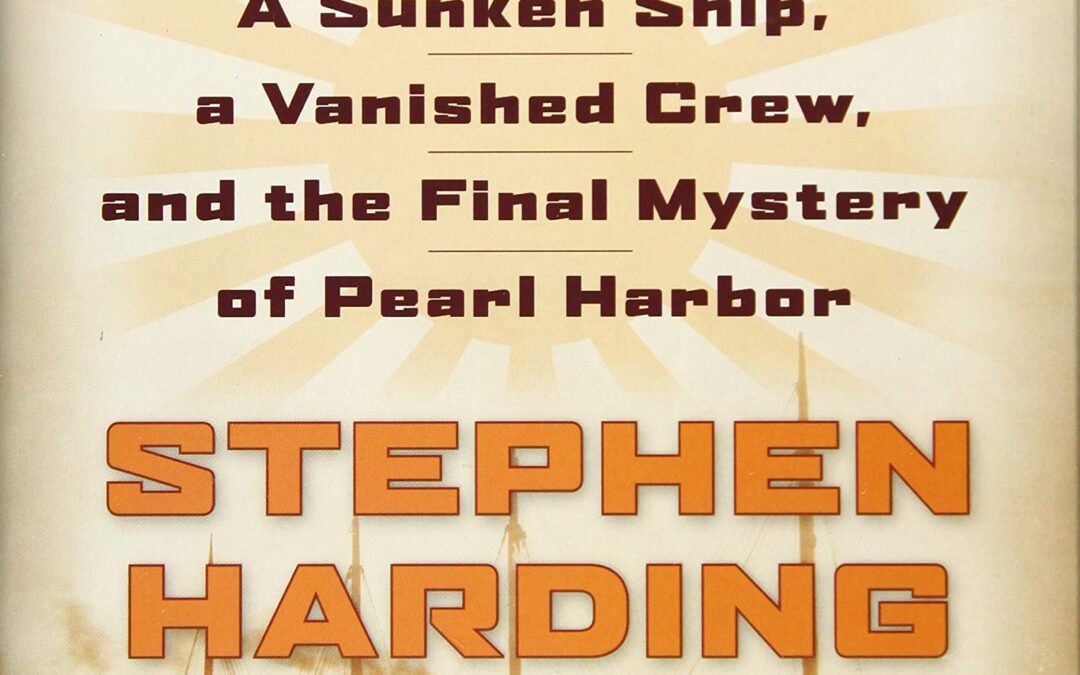
As the Pearl Harbor attack began, a U.S. cargo ship a thousand miles away in the middle of the vast Pacific Ocean mysteriously vanished along with her crew. What happened, and why?
On December 7, 1941, even as Japanese carrier-launched aircraft flew toward Pearl Harbor, a small American cargo ship chartered by the Army reported that it was under attack by a submarine halfway between Seattle and Honolulu. After that one cryptic message, the humble lumber carrier Cynthia Olson and her crew vanished without a trace, their disappearance all but forgotten as the mighty warships of the U.S. Pacific Fleet burned.
The story of the Cynthia Olson‘s mid-ocean encounter with the Japanese submarine I-26 is both a classic high-seas drama and one of the most enduring mysteries of World War II. Did I-26‘s commander, Minoru Yokota, sink the freighter before the attack on Pearl Harbor began? Did the cargo ship’s 35-man crew survive in lifeboats that drifted away into the vast Pacific, or were they machine-gunned to death? Was the Cynthia Olson the first American casualty of the Pacific War, and could her SOS have changed the course of history?
Based on years of research, Dawn of Infamy explores both the military and human aspects of the Cynthia Olson story, bringing to life a complex tale of courage, tenacity, hubris, and arrogance in the opening hours of America’s war in the Pacific.
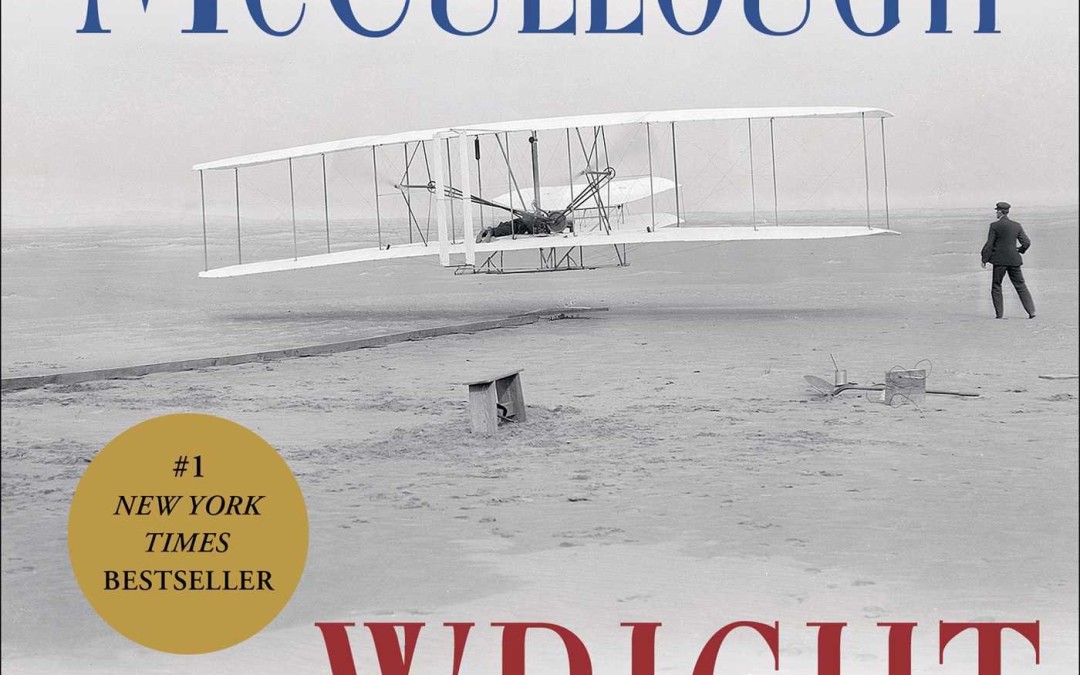
Two-time winner of the Pulitzer Prize David McCullough tells the dramatic story-behind-the-story about the courageous brothers who taught the world how to fly: Wilbur and Orville Wright.
On a winter day in 1903, in the Outer Banks of North Carolina, two unknown brothers from Ohio changed history. But it would take the world some time to believe what had happened: the age of flight had begun, with the first heavier-than-air, powered machine carrying a pilot.
Who were these men and how was it that they achieved what they did?
David McCullough, two-time winner of the Pulitzer Prize, tells the surprising, profoundly American story of Wilbur and Orville Wright.
Far more than a couple of unschooled Dayton bicycle mechanics who happened to hit on success, they were men of exceptional courage and determination, and of far-ranging intellectual interests and ceaseless curiosity, much of which they attributed to their upbringing. The house they lived in had no electricity or indoor plumbing, but there were books aplenty, supplied mainly by their preacher father, and they never stopped reading.
When they worked together, no problem seemed to be insurmountable. Wilbur was unquestionably a genius. Orville had such mechanical ingenuity as few had ever seen. That they had no more than a public high school education, little money and no contacts in high places, never stopped them in their “mission” to take to the air. Nothing did, not even the self-evident reality that every time they took off in one of their contrivances, they risked being killed.
In this thrilling book, master historian David McCullough draws on the immense riches of the Wright Papers, including private diaries, notebooks, scrapbooks, and more than a thousand letters from private family correspondence to tell the human side of the Wright Brothers’ story, including the little-known contributions of their sister, Katharine, without whom things might well have gone differently for them.
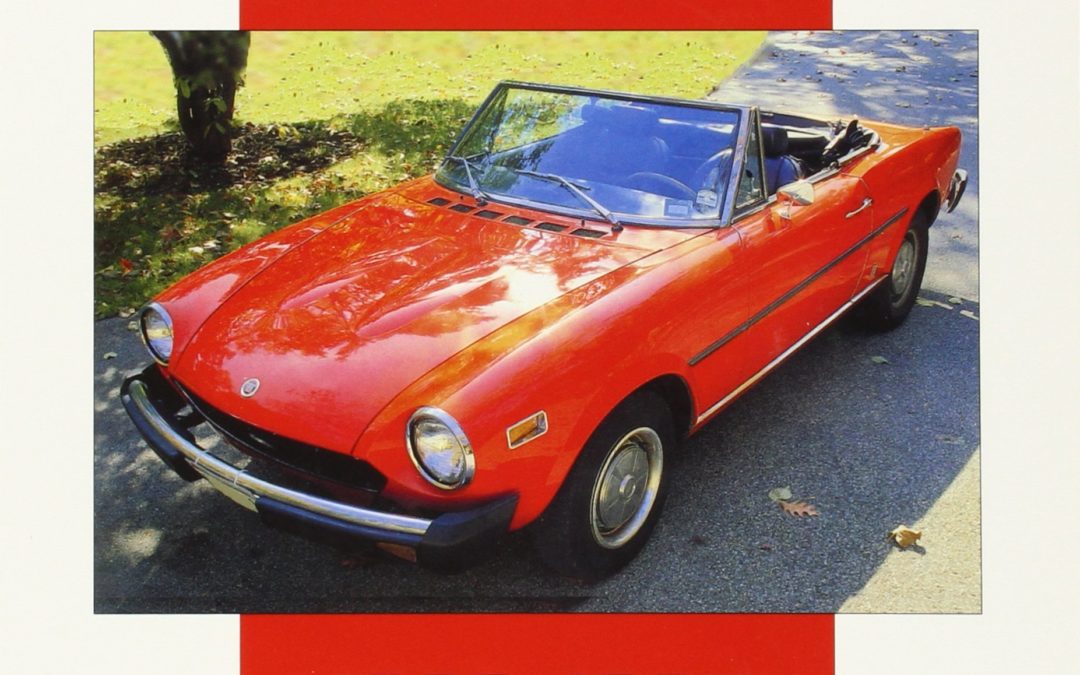
This portfolio covers one of Fiat’s iconic cars, the Pininfarina-designed 124 Spider. Production started in 1966 at which time Fiat also introduced the Coupe. The sixties was a great time for sports cars with the 124 Spider competing with Alfa Romeo Spider, MGB, Triumph TR4 and 5 and the Datsun Fairlady. As the years rolled on by – the Spider would remain in production for almost two decades – Fiat kept up a program of continual improvements that involved regular engine capacity increases to 1608cc, then to 1756cc and finally to 1995cc. Along the way there were only minor cosmetic changes to the styling of the 124 Spider – it remained as pure a design as any during a time of some turmoil in the world’s automobile industry and production ended in 1985.
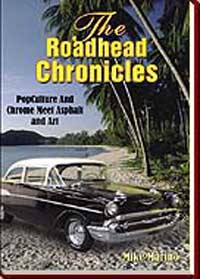
Mike Marino has delivered a one-two punch of a book that goes under the V-8 hood of the American car culture. It’s style is fast paced, rapid fire and colorful, and examines the Chrome-magnon car and pop culture of America with a sense of humor, history, and a dose of horsepower haiku.
THE ROADHEAD CHRONICLES separates the world of the Roadhead into three distinct sections. You’ll jump into the backseat world of Saturday night drive-in movies, V-8’s and Vietnam, fuzzy dice, carhops, jukeboxes, and the rock ‘n roll rebel without a cause switchblade, black leather jacket lifestyle of the blue suede cruise of the 50’s and 60’s, not to mention the muscle-flexing Motor City of the ’70s where GTO’s ruled the roads!
THE ROADHEAD CHRONICLES will also gas up and kick asphalt through the world of Route 66, the kitsch culture of roadside nostalgia, neon motels, cafes, gas stations and diners, along with an offbeat look at Mystery Spots, Rock City and other asphaltian oddities that have become destinations and road culture icons in and of themselves.
THE ROADHEAD CHRONICLES wraps up with previously published articles of Mike’s Roadhead Columns that explore the city where the “beat” goes on in Jack Kerouac’s North Beach, Jerry Garcia’s spare change Haight Ashbury, all the way to Cadillac Ranch and the famous Ken Kesey bus tour of America in the ’60s. So buckle up, lock and load, and get ready to KICK ASPHALT as you fire up the engine and hit the highway in…THE ROADHEAD CHRONICLES!!
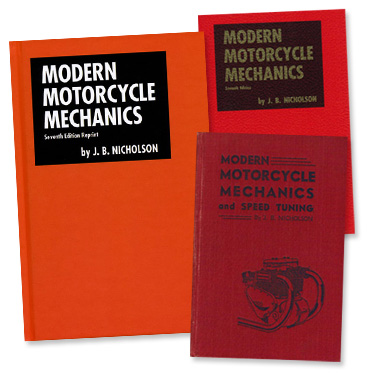
”
Modern Motorcycle Mechanics isn’t so modern anymore.
Yet this hefty reference book last revised in 1974 remains an indispensable source of information for anyone who has ever owned or owns a motorcycle, regardless of make or model. Author J.B. (Bernie) Nicholson of Saskatoon, Saskatchewan covered all aspects of motorcycle repair and maintenance. His advice has literally changed lives.
More than 100,000 copies of this book have sold worldwide since Nicholson wrote the first edition in 1942 making Modern Motorcycle Mechanics a bestseller. For anyone interested in what makes that old bike tick the seventh edition of Modern Motorcycle Mechanics is required reading.
Before Clymer and before Haynes service manuals, there was J.B. Nicholson and Modern Motorcycle Mechanics.
Nicholson, together with his brother Lawrence, opened Nicholson Bros. Motorcycles in Saskatoon, Saskatchewan, Canada in 1933. To this small city in the middle of the Canadian prairie they imported DOT, Calthorpe and Douglas motorcycles and by 1935 the brothers had transformed the business into a fledgling mail order parts supply house.
But it was a 25-year old J.B. (Bernie) Nicholson who published what could be considered one of the first comprehensive texts regarding the operation and maintenance of motorcycles of the day. In 1942 the first edition of Modern Motorcycle Mechanics was distributed widely. They sold the book themselves, and industry giants such as Johnson Motors bought books for resale in their showroom. Floyd Clymer himself ordered hundreds of copies for resale through his motoring catalogs.
Nicholson went on to revise his book six times, with editions appearing in 1945, 1948, 1953, 1965, 1969 and the final and seventh in 1974.
Over the years more than 100,000 copies of Modern Motorcycle Mechanics books have sold from Canada to England, India, South Africa, Australia and beyond.
Jam-packed with Nicholson’s clear and concise service and maintenance information and ever-handy clearance and settings charts for several different makes and models the Seventh Edition Reprint of Modern Motorcycle Mechanics is 766 pages – just like the original. The book covers everything from setting the timing on a single-cylinder Lucas magneto to rebuilding the engine of a Harley-Davidson 45”.
”

Architect John Parkinson died in 1935, and the Los Angeles Times praised him: “Future generations have only to walk through the streets of Los Angeles to be reminded how much John Parkinson in his lifetime contributed to the city that grew up under his hand.” In Iconic Vision: John Parkinson, Architect of Los Angeles, author Stephen Gee proves that this singular visionary created the look of America’s most dynamic metropolis, long before the world recognized the city’s importance. Consider that among more than four hundred buildings in the City of Angels that carried his architectural imprimatur, John Parkinson designed:
- Los Angeles City Hall, the most iconic building in California, the tower that changed a futuristic city’s skyline forever;
- Bullock’s Wilshire, the towering structure that rivals the Chrysler Building as America’s premier Art Deco edifice;
- Los Angeles Memorial Coliseum, the world’s only modern stadium to host two Olympic Games, 1932 and 1984–and still home to the USC Trojans;
- Los Angeles Union Station, the Mission-Moderne-Art Deco masterpiece that brought together California’s railroads and became a legend before the first trains roared in.
Iconic Vision, the first biography of the master architect, documents–in remarkable detail and images–Parkinson’s monumental contributions to the city he loved. Although other architects’ names have become synonymous with the city, John Parkinson designed more landmark buildings in Los Angeles than any other architect, living or dead. And, while other architects may have taken credit for Parkinson’s designs, Stephen Gee’s penetrating biography establishes the truth. He tells the story of a man who envisioned tomorrow.
Autobooks-Aerobooks 2900 W. Magnolia Blvd. Burbank, CA 91505 (818) 845-0707 Hours: Tuesday-Friday 10:00 AM – 6:00 PM Saturday 10:00 AM – 6:00 PM Closed Sunday and Monday Accept Credit Cards gift cardYES, We have Gift Cards - Click Here AUTOBOOKS IS OPEN...
Autobooks-Aerobooks 2900 W. Magnolia Blvd. Burbank, CA 91505 (818) 845-0707 Hours: Tuesday-Friday 10:00 AM – 6:00 PM Saturday 9:00 AM – 6:00 PM "Cars & Coffee" on Saturday morning! Closed Sunday and Monday Accept Credit Cards YES, We have Gift Cards - Click Here Terms...

















